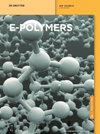高介电常数(La + Nb)共掺杂TiO2及其聚偏二氟乙烯复合材料的制备
IF 3.3
3区 化学
Q2 POLYMER SCIENCE
引用次数: 0
摘要
摘要大量研究表明,使用施主-受主掺杂的TiO2可以获得高介电常数和低介电损耗的陶瓷材料。在本研究中,使用溶胶-凝胶法制备了(La+Nb)-共掺杂TiO2[(La0.5Nb0.5)x Ti1−x O2 x-LNTO]陶瓷粉末。XRD表明,LNTO是金红石相,掺杂后晶格参数发生变化,而X射线光电子能谱解释了掺杂机制,TiO2的掺杂产生氧空位和Ti3+,与掺杂离子形成缺陷偶极子,以提高材料的介电常数。通过物理共混x-LNTO/聚偏二氟乙烯(PVDF)复合材料研究了其介电性能。与TiO2/PVDF复合材料相比,x-LNTO/PVDF的介电性能更加优异。5-LNTO/PVDF的介电常数达到36.96,高于TiO2/PVDF复合材料(19.49),填料添加量为60 wt%和频率为1 kHz。本文章由计算机程序翻译,如有差异,请以英文原文为准。
Preparation of (La + Nb)-co-doped TiO2 and its polyvinylidene difluoride composites with high dielectric constants
Abstract Numerous studies have shown that ceramic materials with high dielectric constants and low dielectric losses can be obtained using donor–acceptor-doped TiO2. In this study, (La + Nb)-co-doped TiO2 [(La0.5Nb0.5) x Ti1−x O2 x-LNTO] ceramic powders were prepared using the sol–gel method. XRD demonstrates that LNTO is a rutile phase, and the lattice parameters change after doping, while X-ray photoelectron spectroscopy explains the doping mechanism, with doping of TiO2 producing oxygen vacancies and Ti3+, which form defective dipoles with the dopant ions to increase the dielectric constant of the material. The dielectric properties were investigated by physically co-blending x-LNTO/polyvinylidene difluoride (PVDF) composites. Compared with the TiO2/PVDF composite, the dielectric properties of the x-LNTO/PVDF composite were more excellent. The dielectric constant of 5-LNTO/PVDF reached 36.96, which was higher than that of the TiO2/PVDF composite (19.49) at a filler addition of 60 wt% and a frequency of 1 kHz.
求助全文
通过发布文献求助,成功后即可免费获取论文全文。
去求助
来源期刊

e-Polymers
化学-高分子科学
CiteScore
5.90
自引率
10.80%
发文量
64
审稿时长
6.4 months
期刊介绍:
e-Polymers is a strictly peer-reviewed scientific journal. The aim of e-Polymers is to publish pure and applied polymer-science-related original research articles, reviews, and feature articles. It includes synthetic methodologies, characterization, and processing techniques for polymer materials. Reports on interdisciplinary polymer science and on applications of polymers in all areas are welcome.
The present Editors-in-Chief would like to thank the authors, the reviewers, the editorial staff, the advisory board, and the supporting organization that made e-Polymers a successful and sustainable scientific journal of the polymer community. The Editors of e-Polymers feel very much engaged to provide best publishing services at the highest possible level.
 求助内容:
求助内容: 应助结果提醒方式:
应助结果提醒方式:


